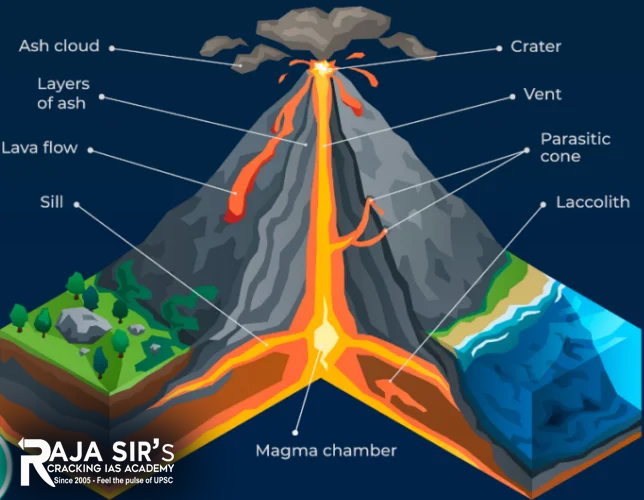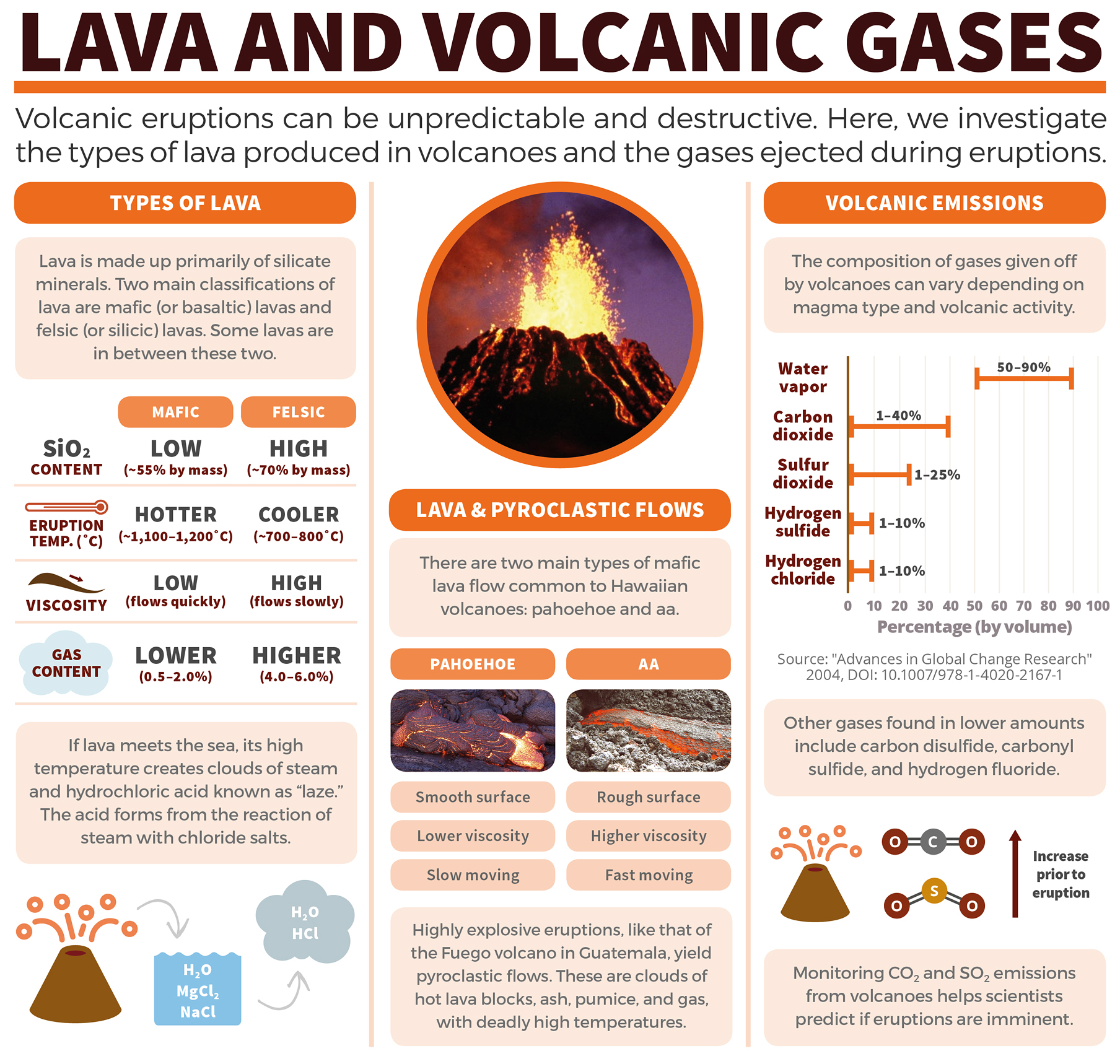- Home
- Prelims
- Mains
- Current Affairs
- Study Materials
- Test Series
Volcanism
- Volcanism or volcanic activity is the phenomenon where solids, liquids, gases, and their mixtures erupt to the surface of a solid-surface astronomical body, for example, planets like Earth, moons, asteroids and comets.
- It is caused by the presence of a natural heat source inside the body. This internal heat partially melts solid material in the body or turns material into gas. The mobilized material rises through the body''s interior resulting in formation of various intrusive and extrusive landforms.
Volcano
- A volcano is an opening in the earth’s crust through which gases, molten rock materials (lava), ash, steam etc. are emitted outward in the course of an eruption. Such vents or openings occur in those parts of the earth’s crust where the rock strata are relatively weak.
- Volcanic activity is an example of endogenic process. Depending upon the explosive nature of the volcano, different extrusive landforms can be formed such as a plateau (if the volcano is not explosive) or a mountain (if the volcano is explosive in nature) or intrusive landforms like baccolith,laccoliths etc.
- Magma vs Lava:
- Magma is the term used to denote the molten rocks and related materials seen inside the earth. A weaker zone of the mantle called asthenosphere, usually is the source of magma.
- Lava is nothing but the magma above the earth surface.Once this magma came out to the earth surface through the vent of a volcano, it is called as the Lava.
- Tools and Methods to Predict Volcanic Eruptions:
- Seismic Data:
- Monitoring earthquakes and tremors as potential precursors to volcanic eruptions.
- Ground Deformation:
- Observing changes in the ground, indicating magma movement.
- Gas Emissions and Gravity Changes:
- Analyzing volcanic gas emissions, gravity, and magnetic field alterations.
 Different Types of Volcanoes
Different Types of Volcanoes
- Based on the frequency of Eruption:
- Active volcanoes:
- They erupt frequently and are mostly located in the Pacific Ring of Fire, which includes New Zealand, Southeast Asia, Japan and the western coast of the Americas.
- About 90% of all earthquakes worldwide strike within this region.
- Volcanic activity is linked to the movement and collision of tectonic plates. Examples include Kilauea in Hawaii and Santa Maria in Guatemala.
- Dormant Volcano:
- These are not extinct but have not erupted in recent history. The dormant volcanoes may erupt in future. Example: Mount Kilimanjaro, located in Tanzania, also the highest mountain in Africa, is known to be a dormant Volcano.
- Extinct or inactive volcanoes:
- These have not worked in the distant geological past. Example: Dhinodhar Hill, Gujarat.
- Based on the Nature of Eruption:
- Shield Volcanoes:
- These are the largest and gentlest volcanoes on Earth, formed primarily from basalt lava.
- They erupt with low explosivity unless water interacts with the vent. The lava flows in a fountain-like manner, building a cinder cone around the vent before spreading out.
- Hawaiian volcanoes are classic examples of shield volcanoes.
- Composite Volcanoes:
- These volcanoes erupt cooler, thicker lava compared to shield volcanoes.
- They are built up over time through numerous explosive eruptions, layering ash, and pyroclastic material with lava flows.
- Mayon Volcano (Philippines), Mount Fuji (Japan), and Mount Rainier (Washington) are some prominent composite volcanoes. The Pacific Ring of Fire is home to many composite volcanoes.
- Calderas:
- These are the most explosive volcanoes, prone to collapsing inward during eruptions rather than building upwards. The resulting depressions are called calderas.
- Flood Basalt Provinces:
- These volcanoes erupt highly fluid lava that travels long distances, covering vast areas with thick basalt flows.
- Mid-Ocean Ridge Volcanoes:
- They are found underwater along the mid-ocean ridge system that stretches for over 65,000 kilometers across the ocean basins, these volcanoes erupt frequently along the central ridge.
Distribution of volcanoes
- Most of the volcanoes in the world are found in three well-defined belts:
- The Circum-Pacific Belt ( Pacific Ring of Fire).
- The Mid-World Mountain Belt.
- The African Rift Valley Belt.
Types of Volcanic Landforms
- Intrusive Volcanic Landforms:
- Sometimes, magma cools and solidifies beneath the Earth''s crust, creating different landforms. These are called intrusive volcanic features.
- Batholiths: These are massive, irregularly shaped masses of igneous rock that form when large bodies of magma cool deep underground.
- Sills and Dikes: Sills are flat, sheet-like intrusions of magma that fill the cracks of Earth’s crust horizontally, pushing the rock layers above them further apart. Dikes, on the other hand, are vertical intrusions that cut through the rock layers like walls.
- Laccoliths: These are dome-shaped intrusions that form when magma pushes up on layers of rock, doming them like a blister.
- Phacoliths: These are lens-shaped intrusions that squeeze into the folds of existing rock layers.
- Monadnocks (Inselbergs): These are isolated hills or mountains that stand out from the surrounding landscape. They form when resistant rock (often intruded by magma) remains after erosion has worn away softer rock around it.
- Extrusive Volcanic Landforms:
- These are created when magma erupts and cools above the Earth''s surface.
- Fissure Vents: These are long cracks in the Earth''s crust that allow lava to flow out in a continuous stream, with minimal explosions.
- Conical Vents: These are the classic volcano shapes with a central vent. Violent eruptions of ash and lava build up around the vent, creating the cone-like form..
- Mid-Ocean Ridges: These underwater mountain ranges erupt frequently due to the constant seafloor spreading. The lava here is less viscous and flows easily, creating vast plains of basalt rock.
- Shield Volcanoes: These are broad, gently sloping volcanoes formed by fluid basaltic lava flows. They erupt less explosively than other types.
- Lava Plateaus: When large volumes of lava erupt and spread out over vast areas, they solidify to form extensive, flat plateaus. Colombia Plateau in the United States and the Deccan Plateau in India are examples of lava plateaus.
- Calderas: These are large, cauldron-shaped depressions that form when the roof of a magma chamber collapses after a powerful eruption.
- Lava Domes: As the name suggests, these are dome-shaped protrusions formed by the slow extrusion of viscous lava that cools and hardens around the vent.

Impacts of Volcanic Eruptions
- Destructive Effects of Volcanism:
- Earthquakes: Magma movement beneath a volcano can trigger earthquakes. These tremors can cause significant ground cracks, leading to widespread destruction and loss of life, particularly in densely populated areas near volcanoes.
- Climate Impacts: Volcanic eruptions release a massive amount of gas into the atmosphere. These gases can disrupt weather patterns and lead to unpredictable climate changes.
- Pyroclastic Flows: Eruptions often generate scorching hot clouds of gas and debris known as pyroclastic flows. These flows move at incredibly high speeds and temperatures, incinerating anything in their path.
- Volcanic Ash: Volcanic ash, composed of tiny rock and mineral fragments, can pose a serious health threat when inhaled. It can irritate the lungs, cause respiratory problems, and even be fatal in high concentrations.
- Constructive Effects of Volcanism:
- Fertile Soil: Volcanic ash, rich in minerals like silica, oxygen, magnesium, potassium, and iron, gets deposited near eruption sites. This ash breaks down over time, creating highly fertile soil ideal for agriculture.
- Land Formation: Repeated eruptions in the same spot can build entirely new landforms, like the Hawaiian Islands.
- Contact Metamorphism: When hot magma comes in contact with existing rock formations, it alters their structure through a process called contact metamorphism. This can create valuable new rock types like marble and hornfels.
- Volcanic Lakes: Large craters formed by eruptions can fill with water over time, creating crater lakes. These scenic lakes can become important sources of freshwater and support unique ecosystems.
- Volcanic Geysers: It’s formation is a consequence of geothermal heating. This process occurs when groundwater interacts with either the high temperatures of igneous rock located at relatively shallow depths within the Earth''s crust, or with the even more extreme temperatures associated with molten magma situated deeper within the Earth.
Volcanism is a powerful and multifaceted geological phenomenon. As we continue to advance our understanding of volcanic processes, we should strive to not only mitigate the associated hazards but also appreciate the constructive contributions of volcanoes to the ever-evolving geological landscape of our planet. Its effects range from devastating earthquakes and climate disruptions to the creation of fertile soils and unique geological features. Understanding its complexities is essential for both managing its hazards and harnessing its benefits sustainably.









 Latest News
Latest News
 General Studies
General Studies